The following is a transcript of the presentation video, edited for clarity.
Point/Counterpoint: There are multiple paths to success.
Another fork in the road.
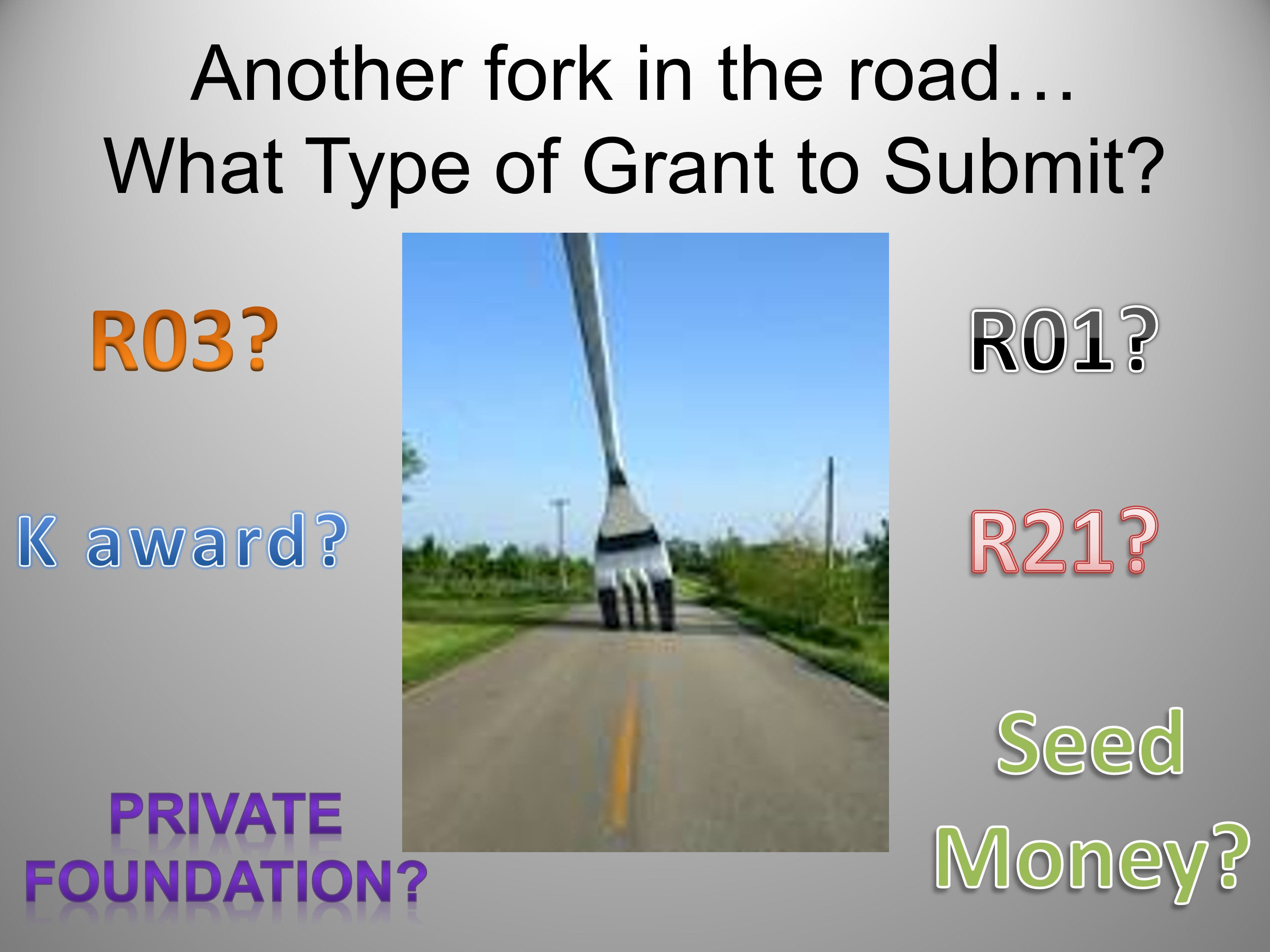
There is not just one yellow brick road that takes you to social impact, R01s, tenure, pursuit of happiness and lots of stuff. There are lots of different roads of different colors and different difficulties. So the idea is this: What can we say about what those pathways are, and what are some guidelines that might be useful to you as you consider your own pathway?
All right. Now what I’m going to do is to have two people who are going to do this point/counter point.
“Professor Heckle”: Get an early start with a K award or R03.
Let’s just start with Professor Heckle on this one.
Research and Sponsored Programs or Grants Administration Office
Full Size | Slide (.ppt)
The first thing to think about, when you land yourself, whether you’re a postdoc or whether you’re a new faculty member, one of the most important offices for you to become acquainted with on your campus or institution is something called Research and Sponsored Programs. It may also be called something like Grants Administration Office. Grants Office. Something like that.
Their job is to help investigators. That’s why they’re there. And what they’ll do is to give you information on finding funding sources. They have lots and lots of databases, and they can give you ideas about where you might get funding.
They can help you prepare proposals. They have the software. They can give you guidance in using that software to develop proposals.
They can help you set up an award. So if you do get a grant, they can help you to make sure that everything is underway. That you got the accounts properly established. That you can draw the money when and where you need it.
They can also help you manage an award. There are various kinds of issues that have to be solved with regard to personnel. With regard to equipment. And there’s things that you might not know. And some of these things are kind of arcane, because they’re lodged in the institutional history of that particular place. So you may not know all of the fine details, all of the nuances.
They can also help you close out the award when it comes time to do that. So this is a very important agency to be involved with.
Pathways to the R01

Now, speaking as Dr. Heckle, the NIH provides lots of opportunities for you to get research grant support, starting from your very youngest days. Even while you’re a graduate student. All the way up to the wonderful, glory days of the R01. So these are different tracks you can follow. Some of you have already mentioned F awards. Some of you have had support for doctoral dissertation, for example. You can also get a K award. You can get an R03 — which is mentioned here today. An R21. Or you can even just skip directly from getting your PhD to applying for an R01.
Now there are a number of reasons why those intervening paths are important. I’m going to assume that ultimately everybody wants an R01. That’s the goal. That’s at the end of the pathway. But there are different ways of getting there. So you can go one way or another way. Depending upon what your goals are. Where you are. And what kinds of limitations and facilitations are available to you.
Major Types of NIH Grants

There are several different types of grants. And I’m going to mention specifically K awards and R03 awards. Because for people who are just beginning to get a start in research, working for the R01 may not be the best route.
As you all know, R01s are not easy to get. The pay line is very, very difficult to reach. And there are lots of people who submit an R01 and they come back with that dreaded NS — not scored. They were triaged. They weren’t even in the game. So then they have to amend. There will be greater opportunities by going to other kinds of grants, including K awards and R03 awards.
Now notice for the K award, typical duration 3 to 5 years, depending on what the K award is. And they pay up to $150,000 a year. And you’ll hear more from Dr. Sklare on this later today.
The R03 award gives you funding for 2 years up to $50K. And it gives you a chance to get your foot in the door. It gives you a chance to say yes, I am a funded NIH investigator. It gives you money. It helps you to tell your department or your institution, I am a funded investigator. I earned some money. I may not be big, but I’ve got a start. And it indicates that people thought well enough of my research that they said yes, we’re going to give you some money.
Average Age of Principal Investigators
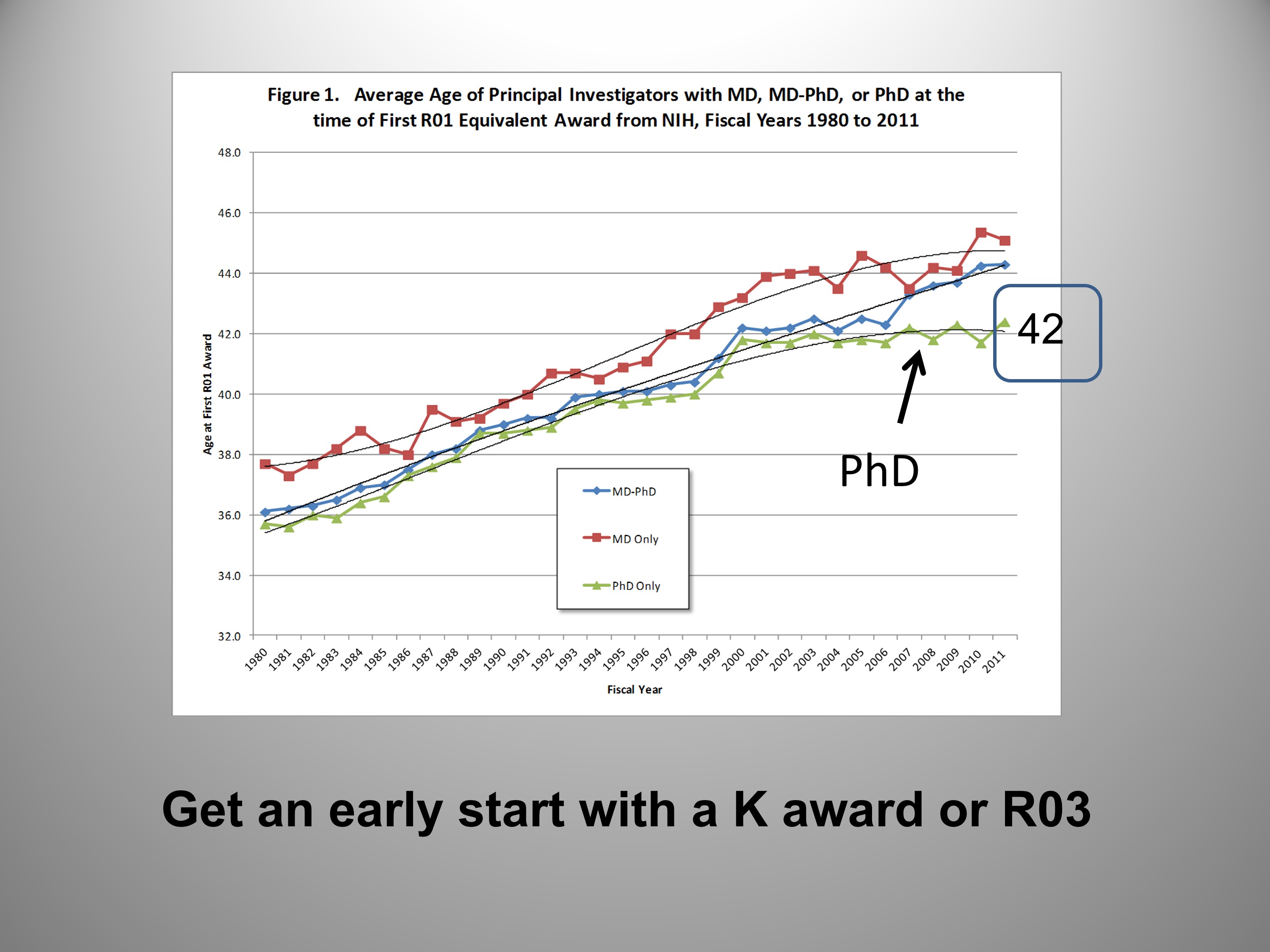
This is very important because if we look at the average age of the PhD getting an R01 or R01 equivalent award today: It’s 42 years of age. According to some research, 42 years of age is when the brain begins to shrink. Which is an unfortunate coincidence.
But in any case, notice that it’s not until the age of 42 that many people have, for the first time, an R01. So they’ve been sitting around in some faculty position or research position for a long time, waiting for this big R01. But that’s really a long time.
So NIH has helped. They’re aware of this problem. They want to make sure the younger investigators are able to do the work they want to do. They want to get in the laboratory and they need support for it. So that’s why we have those kinds of awards.
Research Career Development Awards
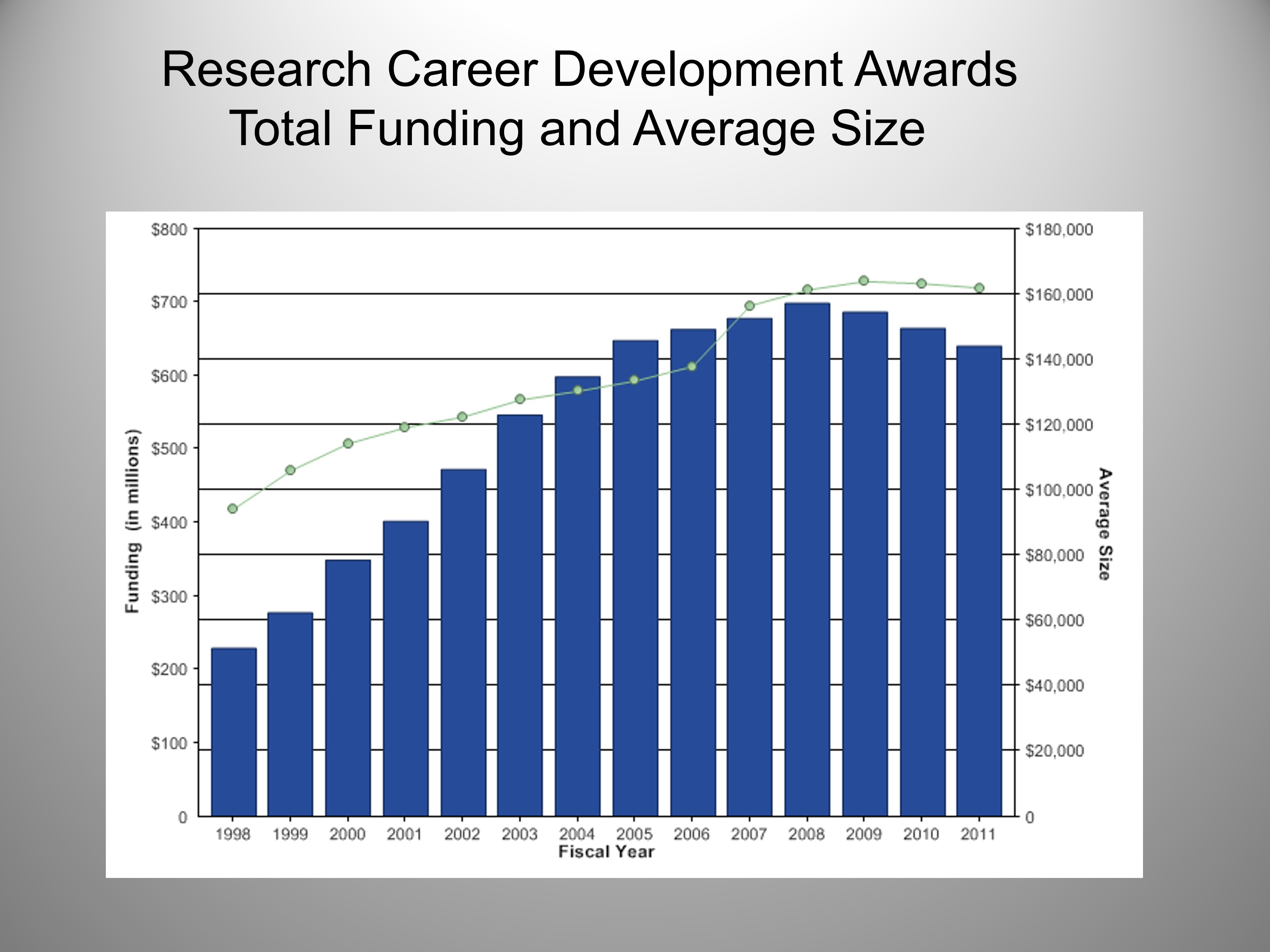
Now here is some data on the K award. The Research Career Development Awards. It gives you some idea of the average size of the grant. And you can see how the numbers of these have increased. And you can see that that’s a good deal better than the R03, which is after all capped at $50,000 a year. That’s not a lot of money to undertake a research program.
Success Rates for Selected K Activities

There are other reasons to be interested in the K award. Let’s look at success rates. Now these data are a little bit hard to get. These are data from NIH. And these are NIH success rates for selected K activities. Especially the K08 and the K23. And we won’t take time to detail those now. You’ll hear more about those later. But notice that the success rates are generally above 30% for those. Long-term average going from 1996 up until about 2010. The most recent data that were reported by this particular agency.
Now if you compare that with R01s: getting the pay line for R01s is not easy. Because a lot of the member institutes do not share their pay lines. Some of them do. For those who did, I calculated an average, and it turned out to be about 11%. Which at least until very recently, was the estimated pay line for NIDCD RO1s this year. I guess it’s gone up somewhat since that time.
But the idea is, when you’re asking where should I submit? Think not only about the type of grant. Try to get some data on pay lines. It makes sense. If you’re going to pay the lottery, you might as well go where the odds are with you. Now notice the odds are better if you’re submitting K award, than if you’re submitting an R01.
K awards have other virtues that you’re going to hear about. They can provide lots of good mentoring opportunities and can be a very effective bridge into certain types of clinical research. So think carefully about those kinds of options.
“Dr. Snyde”: Why submit R01s? That’s where the money is.
Time for a switch. This is Dr. Snyde speaking now.
That’s where the money is.

When Willie Sutton was asked, why do you rob banks? He said, because that’s where the money is.
Why submit grant applications to NIH? Because that’s where the money is.
Why submit R01s? Because that’s where the money is.
If you submit an R03, you’re going to get how much money? $50,000. For how many years? Two years? Come on! What’s that going to do for you? Unless you’ve got some huge startup package $50,000 a year is not going to pay for much of anything.
If you have anything that’s demanding in terms of resources. If you need consumables. If you need to pay for research participants. If you need to pay part of an imaging facility. If you need to do anything, $50,000 is going to go very, very quickly. Yeah, it’s good to have on your CV. But what does it really buy you in terms of building a research program?
Also think, two years. If you want to submit an R01 application, and you’re thinking the R03 is the bridge to an R01, by the time you get your R03 rolling, and you collect your first preliminary data, you want to be writing your R01. In other words, there’s no time. No time really to take benefit of the R03. What will likely happen is you’ll plug away on the R03, living on a shoe string. Finish your two years, and then you’d have to have a hiatus while you plan to submit your R01.
So you just lost 2 years of your tenure track life sitting on an R03 application. Does that make sense?
By the Numbers
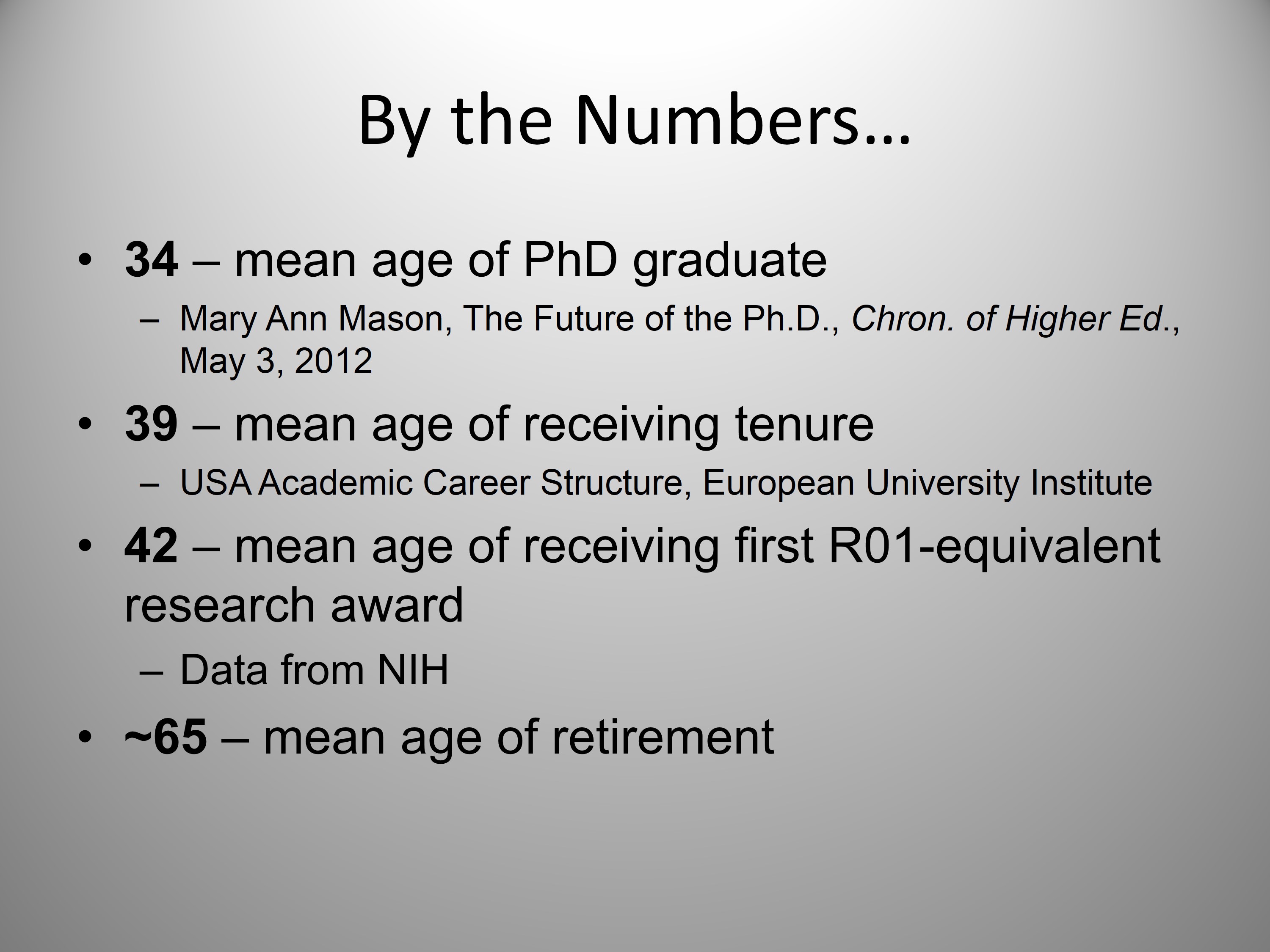
Let’s consider it by the numbers. The average age of the PhD graduate is 34. The mean age of receiving tenure in the United States is 39. The mean age of receiving the first R01 equivalent research award is 42. And as I mentioned, this is about the time that the brain begins to shrink. And then we finally retire at age 65.
Notice that there’s a lot of stuff that happens during these 30s and 40s. That’s when people are really hitting the road.
The Graying of the R01 PI
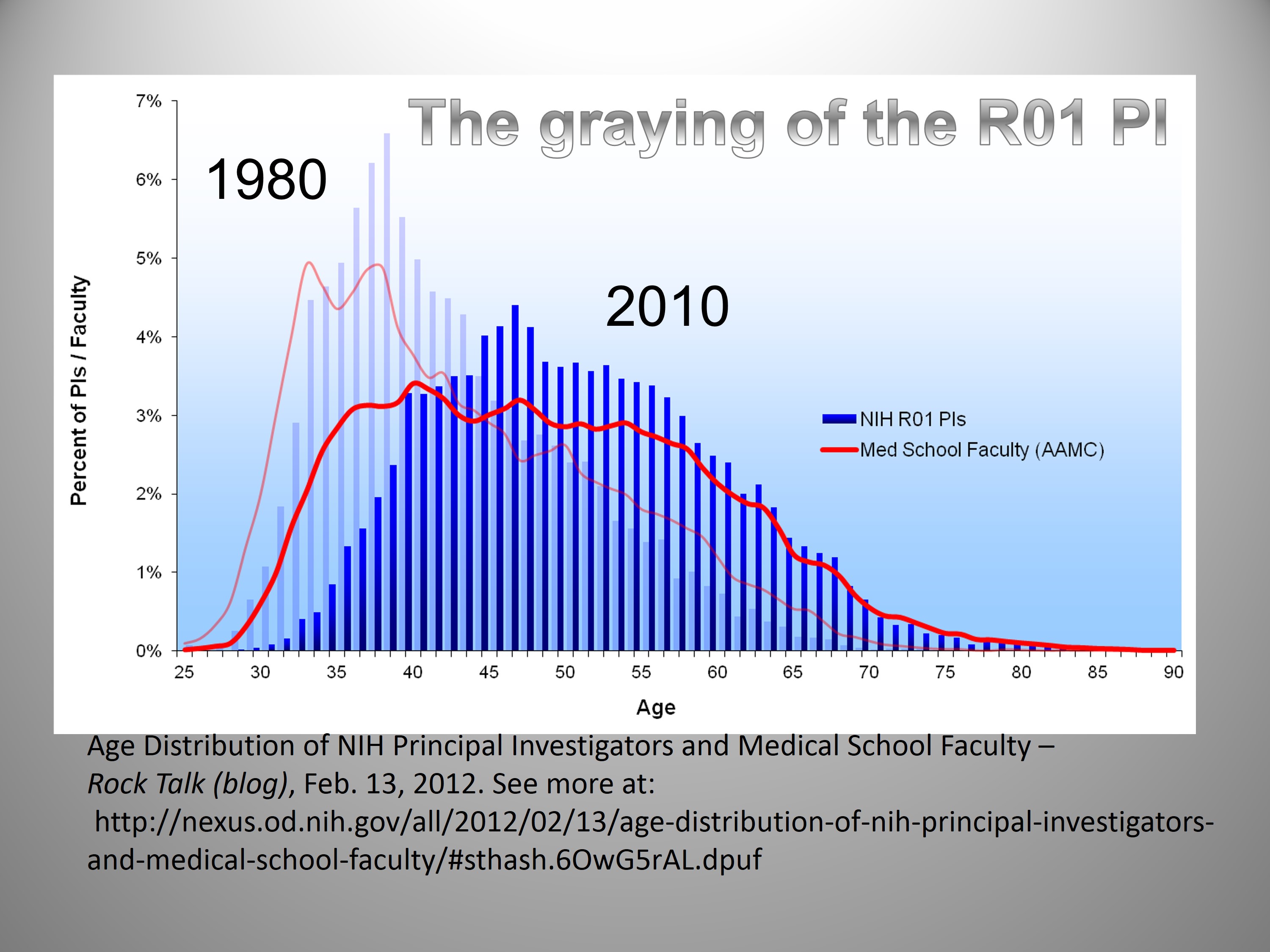
It’s a changed situation. This was not always like this. This slide I got from NIH. This I call the graying of the R01 PI. Notice back in 1980s, that’s the left-most distribution. Kind of the light blue color — bluish- gray. Notice that at that time, looks like the modal age of the R01 PI was, what? Less than 40? Thus we had a lot of 30 year olds.
But notice what happened as we get to 2010. The whole thing shifts. We’ve got a demographic shift. And now our R01 PIs are getting older. The good side is, there’s some guys in there 75s; some men and women in their 75th year who are still PIs in R01s.
The sad part of the story is, notice what’s happened to our people less than 35? They’re almost invisible. So we’re seeing this entire shift. So that’s why NIH is concerned. That’s why they give you things like the R03. That’s just a sob, as to say we feel sorry for you. And we’re going to try to give you a little bit of research money so you’ll be encouraged and you won’t give up research.
That’s nice of them, but it’s not real money is it?
Percent of Unsolicited R01 Projects Funded
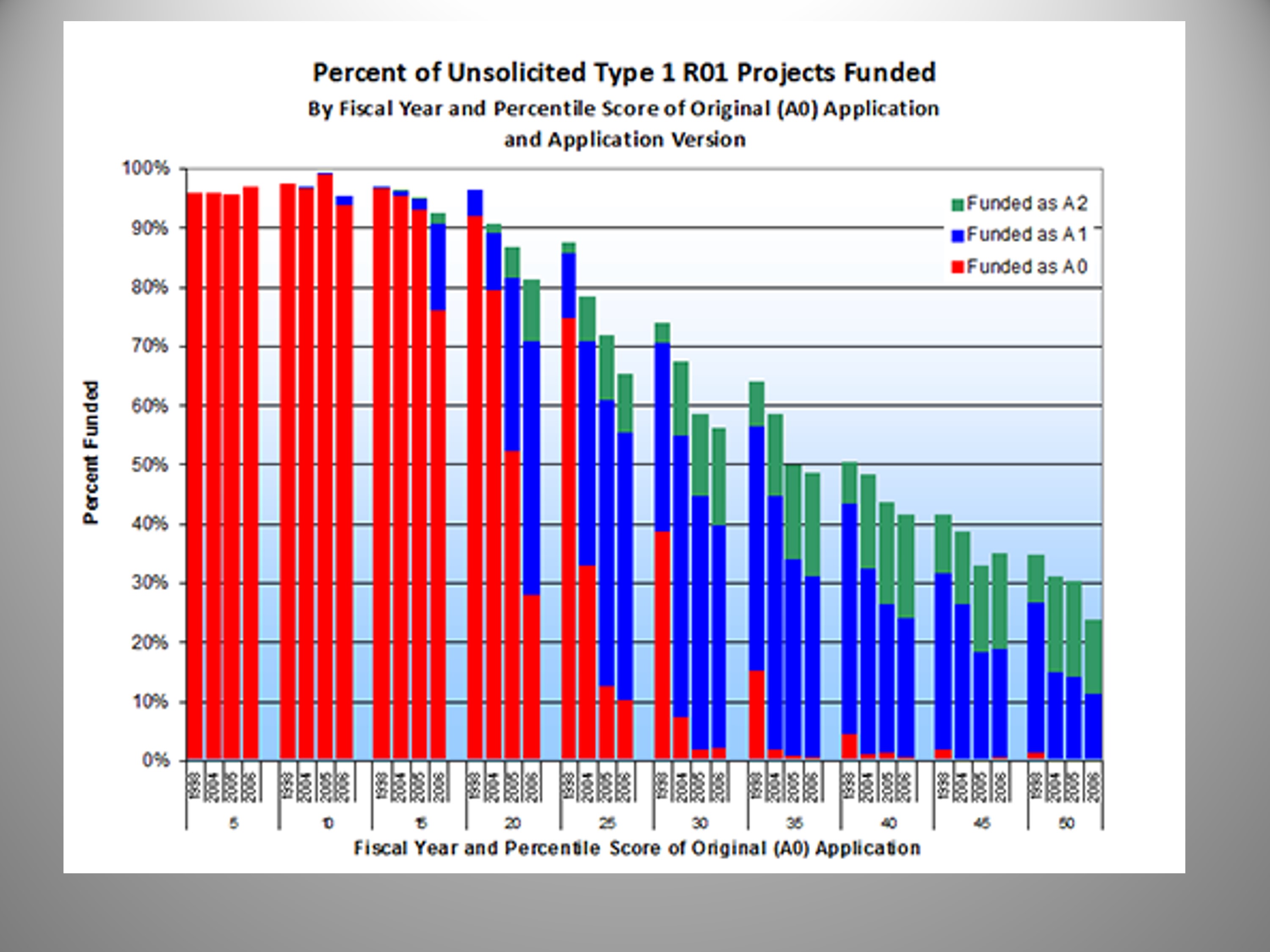
This gives you an idea of what happens with R01s. You can get these data from NIH. And this shows you the percent of unsolicited type R01 research grants that were funded. So these are field initiated, as most of them are. And you can see if you have a really high percentile score to the left of the slide there, some of those are funded right off the bat. As the priority score goes down, all the way to 50 to the extreme right, notice that there’s very little in the way of funding possibility, even with the first and second amended application. So if you get a very low score, bear in mind the odds are really against you of ever getting funded, no matter how much you amend it. And there are various reasons for this. But just be aware. When you get a bad score on a R01, think carefully about whether you should amend it. Or whether you should redirect and maybe find another topic.





